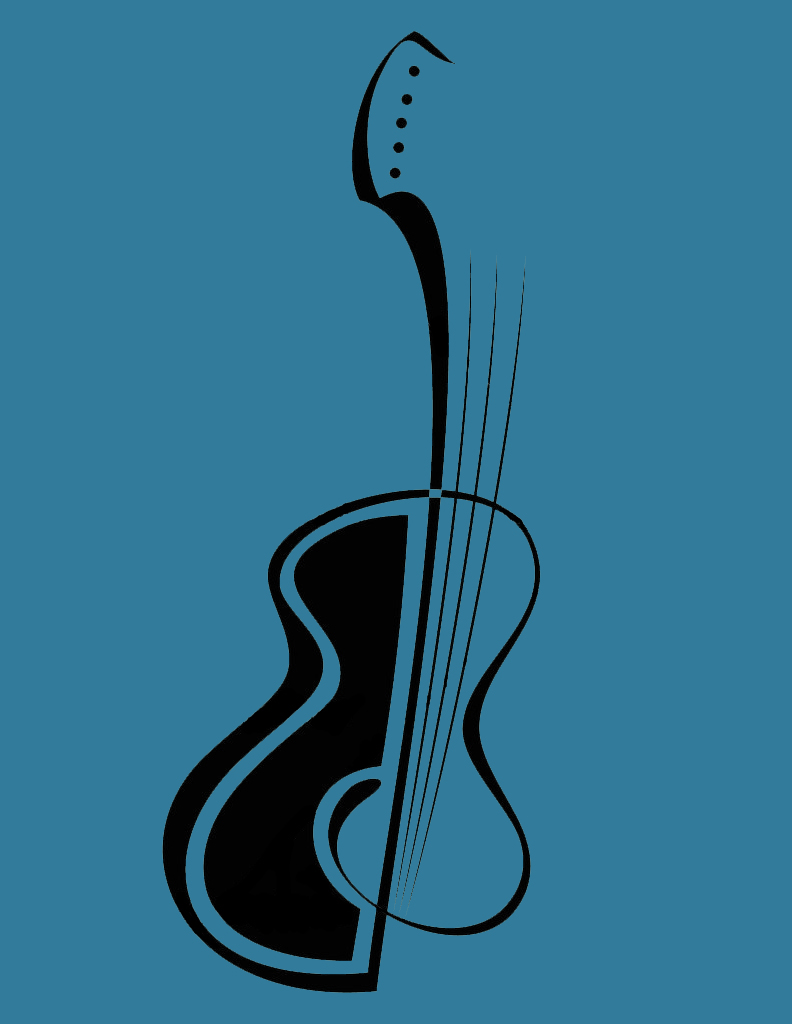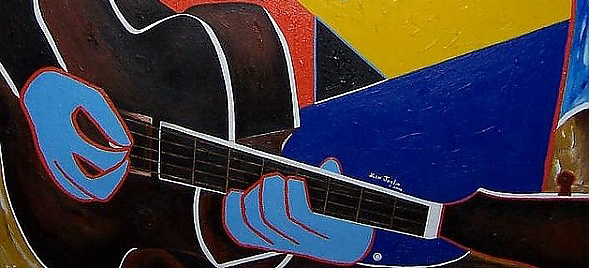Ready to Take Your Playing To The Next Level?
What Is The Bebop Guitar Improv Series? / Who Is This Training For? / The 5 Key Sections of this Program / What’s Inside? / Who Is Richie Zellon? /
Books only versus Online Program / Testimonials


About the “Bebop Guitar Improv Series”
Developed over a 10 year period, The Bebop Guitar Improv Series consists of two volumes, with multi-media materials. It is intended as a guide to lead both the player with little or no formal improvisation skills, as well as the player who does so exclusively by ear, on the journey to becoming a seasoned jazz improviser. Each volume is comprised of 3 books: the Lesson Book, Workbook, and Scale & Arpeggio Fingerings guide.
Volume 1 is devoted to using the blues tonality as the primary vehicle to teach the rudimentary principles of jazz improvisation in theory and practice. Structured with the novice improviser in mind, it initially focuses on learning how to systematically develop a vocabulary to improvise over chord changes from a guitar-oriented technical perspective. Four varieties of 12 bar blues are covered in order of difficulty:
1) Traditional Blues (I-IV-V), 2) Jazz Blues (introducing II-V cadences), 3) Minor Blues, and 4) Bird Blues (Charlie Parker style).
Each new progression is taught throughout a series of etudes, and gradually introduces one or more of the chord/scales required to improvise over most jazz standards. Various melodic concepts and syncopated rhythms commonly used in the swing/bebop idioms, are taught as well.
Volume 2 builds on the principles explored in Volume 1 and explores various applications over “Rhythm Changes,” as well as major, minor and extended tonalities. The technical focus is on multi-positional playing using the entire fretboard.

About RICHIE ZELLON
Author
Richie Zellon, guitarist, composer, and music educator, has held teaching positions as professor of jazz guitar at Florida International University (Miami) the University of South Florida (Tampa) The Music Workshop (Orlando) and his own venue, Miami Jazz Guitar.
With several critically acclaimed recordings under his name, Zellon has recorded and/or performed with some of the most influential musicians both in the mainstream and Latin jazz genres. Among them, Paquito D’ Rivera, David Leibman, Jerry Bergonzi, Sam Rivers, George Garzone, Danilo Perez, Jeff Berlin, Abraham Laboriel, Alex Acuna and Ignacio Berroa to name a few.
Due to his innovations in the field of jazz and latin music he has been profiled in several important books such as “The Great Jazz Guitarists” by Scott Yanow, “The Jazz Guitar: Its Evolution, Players and Personalities Since 1900” by Maurice J. Summerfield ,“El Diccionario de Latin Jazz” by Nat Chediak , “Caliente: A History of Latin Jazz” by Luc Delanoy and “Jazz Jews” by Michael Gerber.
For almost a decade, he wrote an instructional column for Jazz Improv magazine. In addition to his dedication to mainstream jazz, his ongoing research on the music of various Latin American cultures and their fusion with contemporary music has been a sought after topic by musicians at international clinics and workshops as well.
Each Lesson in this Series consists of 5 key sections which as a whole explore the different areas required to develop an improvisational vocabulary in the bebop idiom:
The Jazz Etudes
The Jazz Etudes, written in both regular notation and tab, are the heart and soul of this method. They serve as models to train the aspiring improviser in utilizing the melodic techniques and rhythms taught in each lesson. They are presented in order of gradual difficulty.
The Scale & Arpeggio Fingerings
The 7 heptatonic scale and arpeggio fingering patterns, supply the guitarist with the technical resources required to properly execute even the most intricate melodic phrases, anywhere throughout the fretboard.
The Bebop Calisthenics
These custom exercises work simultaneously at many levels to help your improvisational skills flourish. They help reinforce the use of various linear melodic concepts introduced, expand your understanding of their spontaneous application anywhere on the fretboard, and provide ear-training.
The Rhythm Lab
This segment of the lessons introduces and breaks down the various syncopated rhythmic figures that are commonly employed in mainstream jazz, in order to facilitate “sightreading”.
The Rhythm Templates
These templates consist of different harmonic progressions and rhythms devoid of any note values. They have been carefully structured to guide you step by step in supplying the missing pitches, using the unique melodic concepts introduced in each lesson. Throughout this procedure the student learns to systematically develop the vocabulary necessary to improvise over a given chord progression by filling in the missing notes.
In addition to the 5 specific sections described above, towards the end of each lesson a quiz is included so that the student can gauge his/her understanding of all the theoretical concepts introduced to that point.
Who is this training for?
To determine if this training is for you, please answer “yes” or “no” to the following questions and then check your score at the bottom.
-Are you clueless as how to develop an improvised solo that flows smoothly over a given chord progression?
-Do you rely on memorized “licks” when playing a solo?
-Do you start a different “lick” every time there is a chord change?
-Do your ideas end abruptly or lack continuity when improvising over changes?
-Are your ideas devoid of syncopation (“they don’t swing”) and lack rhythmical variety when improvising?
-When you improvise, does it sound like you’re just running scales versus playing coherent melodic lines with a sense of direction?
-When soloing over a chord progression, if you were suddenly left unaccompanied, do you feel that your ideas would fail to clearly convey the prescribed changes?
-Do you feel like you’re in a rut and your practice routine is inefficient?
-Do you lack the resources and understanding of how to link any given scale or arpeggio both horizontally and vertically throughout the entire fretboard?
If you answered yes to one or more of the above questions, this program will benefit you!

Books versus Online Program
While the book series alone is a great learning resource, the online program in conjunction with the printed books is a superior choice due to the added video!
Almost all the lessons and exercises in the books are demonstrated in detail through 100+ streaming videos, with additional commentary which further contributes to the learning experience. What this means to you is that you will be able to practice each exercise along with the teacher and have the freedom to watch it played at different tempos as many times as you wish…24/7!


9 Modules, jam-packed full of practical information!
The course consists of 9 modules. Each new module builds on the information provided in the previous one. To give the student enough time to exclusively focus on each fundamental block of information and to avoid overwhelm, each new module is opened up monthly. Students have an additional 3 months after all 9 modules are delivered to access all the information online . Those that do not feel this is sufficient time to assimilate the material, have the option to continue studying and practicing on their own after the entire course has been delivered. If you currently lack the skills or time to complete the course during the 9 month period, all the relevant material to continue at your own leisure is downloadable!
The following is just a brief outline of what you’ll learn…..
MODULE #1
- Fundamentals for the development of improvisational skills in the Jazz idiom.
- How a Tonality is Established. Understanding the Blues Tonality.
- The 7 Fingering Models for every Scale & Arpeggio family.
- All about Vertical & Horizontal Scale & Arpeggio Relationships.
- How to use the Fingering Cycles.
- How to use Guide Tones, Voice Leading and Melodic Contour to smoothly transition through any set of chord changes when improvising.
- How to properly play Swing 8th notes.
- How to Read and Write Intervallic Script
- …plus training videos, audio downloads & detailed exercises to help you apply all the information in your playing!
MODULE #2
- How to use Approach Tones
- How to differentiate Harmonic vs. Non-Harmonic Tones
- The Anatomy of A Bebop Line
- How to Use Diatonic & Chromatic Passing Tones
- How to Use Diatonic & Chromatic Neighboring Tones
- Bebop Calisthenics #1
- 5 Jazz Etudes in Regular Notation, Tab & Intervallic Script
- How to write your own Jazz Etude to program new vocabulary
- Theory Quiz #1
- Guided improvisation assignments applying the melodic concepts and rhythms introduced
- Understanding how to Read, Write & Play different Syncopated Rhythms
- …plus training videos, audio downloads & detailed exercises to help you apply all the information in your playing!
MODULE #3
- Modal Ambiguity and How To Avoid It
- How To Use Harmonic Anticipations
- How to Use Unprepared Approaches
- How to Use 2 Note Enclosures
- Bebop Calisthenics #2 using Unprepared Approaches
- Bebop Calisthenics #3 using 2 Note Enclosures
- 3 Jazz Etudes in Regular Notation, Tab & Intervallic Script
- Theory Quiz #2
- Guided improvisation assignments applying the new melodic concepts and rhythms introduced
- …plus training videos, audio downloads & detailed exercises to help you apply all the information in your playing!
MODULE #4
- Introducing Upper Extensions and How to Use Them Effectively
- Jazz Etudes Opus #9 & 10 – Blues featuring Upper Extensions (variations 1& 2)
- Theory Quiz #3
- Example of Writing an Etude using Rhythm Template #7
- …plus training videos, audio downloads & detailed exercises to help you apply all the information in your playing!
MODULE #5
- Introduction to Modal Interchange
- Major II-V-I Cadences
- How To Use The IV-7 Chord
- Introduction To Double Chromatic Approaches
- Bebop Calisthenics #4 Arpeggios with Double Chromatic Approaches
- Jazz Etudes Opus #11, 12 & 13 – Blues featuring Double Chromatic Approaches (variations 1, 2 & 3)
- Theory Quiz #4
- Example of Writing an Etude using Rhythm Template #9
- …plus training videos, audio downloads & detailed exercises to help you apply all the information in your playing!
MODULE #6
- Introduction to 3 Note Enclosures
- Bebop Calisthenics #5 Arpeggios with 3 Note Enclosures
- How Secondary Dominants Function
- Introduction To The V7 Altered Chord & Modal Superimposition
- Jazz Etudes Opus #14, 15 & 16 – Blues featuring Altered Dominants & 3 Note Enclosures (variations 1, 2 & 3)
- Theory Quiz #5
- Example of Writing an Etude using Rhythm Template #11
- …plus training videos, audio downloads & detailed exercises to help you apply all the new information in your playing!
MODULE #7
- Introduction to 4 Note Enclosures
- Minor Blues
- Minor II-V-I
- Cadences using the Locrian, Super Locrian and Aeolean Modes
- Jazz Etudes Opus #17, 18 & 19 – Blues featuring 3 Note Enclosures (variations 1, 2 & 3)
- Theory Quiz #6
- Example of Writing an Etude using Rhythm Template #13
- …plus training videos, audio downloads & detailed exercises to help you apply all the new information in your playing!
MODULE #8
- Introduction to New Fingering Models that will enable you to link together the entire fretboard within any tonality
- Jazz Etudes Opus #20, 21, 22 & 23 – Blues featuring New Fingering Models (variations 1, 2 ,3 & 4)
- Bebop Calisthenics #7 using various approach tones over Locrian & Super Locrian based arpeggios
- …plus training videos, audio downloads & detailed exercises to help you apply all the new information in your playing!
MODULE #9
- How to use Overlapping Fingering Patterns to shift registers
- Jazz Etudes Opus #20, 21, 22 & 23 – Blues featuring New Fingering Models (variations 1, 2 ,3 & 4)
- Harmonic Analysis of Bird Blues
- Secondary II-V Cadences, Dominant Chains, Substitute Dominants & Interpolated II minor chords
- Jazz Etudes Opus #24, 25, 26 & 27 – Bird Blues… -Putting it All Together! (variations 1, 2 ,3 & 4)
- Quiz #7
- …plus training videos, audio downloads & detailed exercises to help you apply all the new information in your playing!

SILVER
Books Only- 3 Course Books in PDF
- Audio MP3s of all Jazz Etudes & Selected Exercises
- Band in a Box Practice Files for all Jazz Etudes
GOLD
Independent Study- 3 Course Books in PDF
- Audio MP3s of all Jazz Etudes & Selected Exercises
- Band in a Box Practice Files for all Jazz Etudes
- Complete Video Training Library
- 24/7 Access to Members Download Area for 12 months
PLATINUM
Guided Study- 3 Course Books in PDF
- Audio MP3s of all Jazz Etudes & Selected Exercises
- Band in a Box Practice Files for all Jazz Etudes
- Complete Video Training Library
- 24/7 Access to Members Download Area for 12 months
- 6 Private Skype Lessons with Richie
- 3 Personal Evaluations of Your Completed Written Assignments
- NOTE: In order to properly serve its participants, this program has a LIMITED OCCUPANCY!